SEO
How to Build an SEO Roadmap in 7 Steps (Template Included)
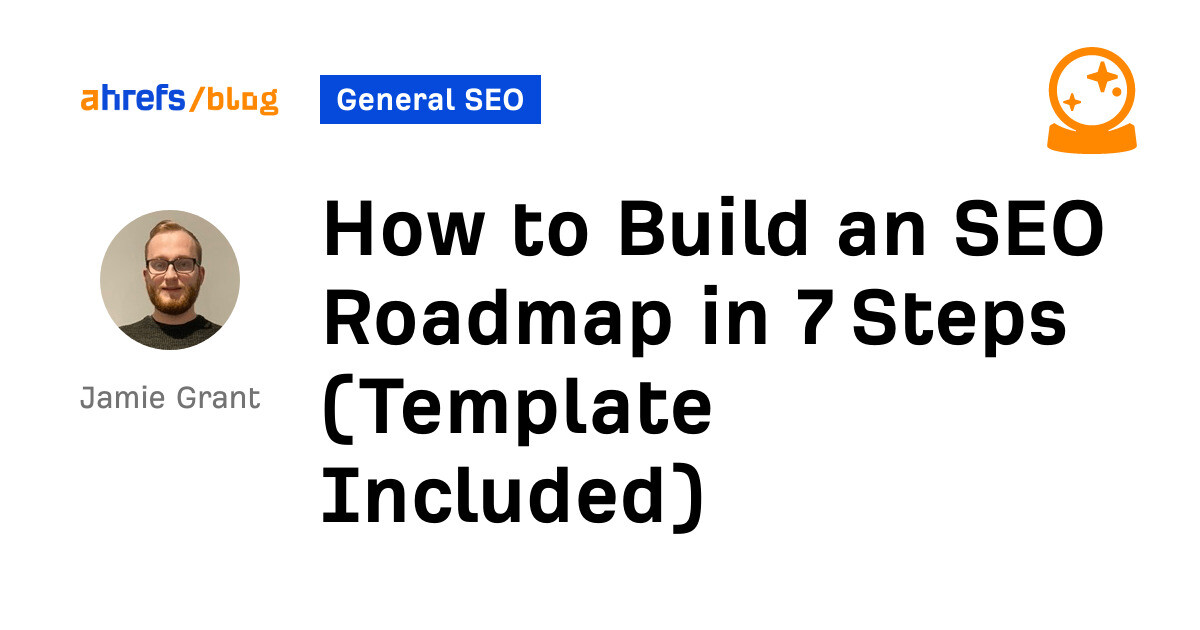
The SEO roadmap is one of the most important documents in an SEO campaign. Not only does it formalize your SEO strategy, but it’s also used as a tracker for actioning your SEO tasks.
There’s no set way to build a roadmap. For over four years, I’ve been working in SEO agencies building a ton of roadmaps. As a senior SEO strategist at Kaizen, I oversee the SEO strategy for all clients. So it’s fair to say I spend a lot of time working with SEO roadmaps.
I’ve leaned on this experience to share some top tips for creating your roadmap. I’ll break down the process into seven easy-to-follow steps that you can start applying in my Google Sheet template to create your first SEO roadmap.
An SEO roadmap is a strategic plan of action used to formalize and track key tasks within an SEO campaign.
This document is typically created within the first three months of an SEO campaign and will often set out the plan for a period of six to 12 months.
The SEO roadmap is often referred to as a “living” document, meaning updates and amendments should be made where necessary as the SEO strategy is adapted and developed over time.
Building a roadmap will ensure all parties are clear on the tasks ahead.
From development teams to content writers, the roadmap will provide an early indication of the workstreams they will be needed for, when they will be needed, and how much resource they’ll need to assign.
It should be treated as more of a “loose guide,” particularly at an early stage. Having the roadmap in place early on can help you get the ball rolling and start conversations with the people involved in bringing your strategy to fruition.
This will help you align priorities and plan the use of resource in advance. Some compromises may need to be made. However, getting on top of this early means you can set up your roadmap for the most effective use of resource possible.
Say for example, you are creating an SEO roadmap for a gifting e-commerce website. The development teams may advise against any plans to use development resource during the notoriously busy Black Friday and Christmas periods.
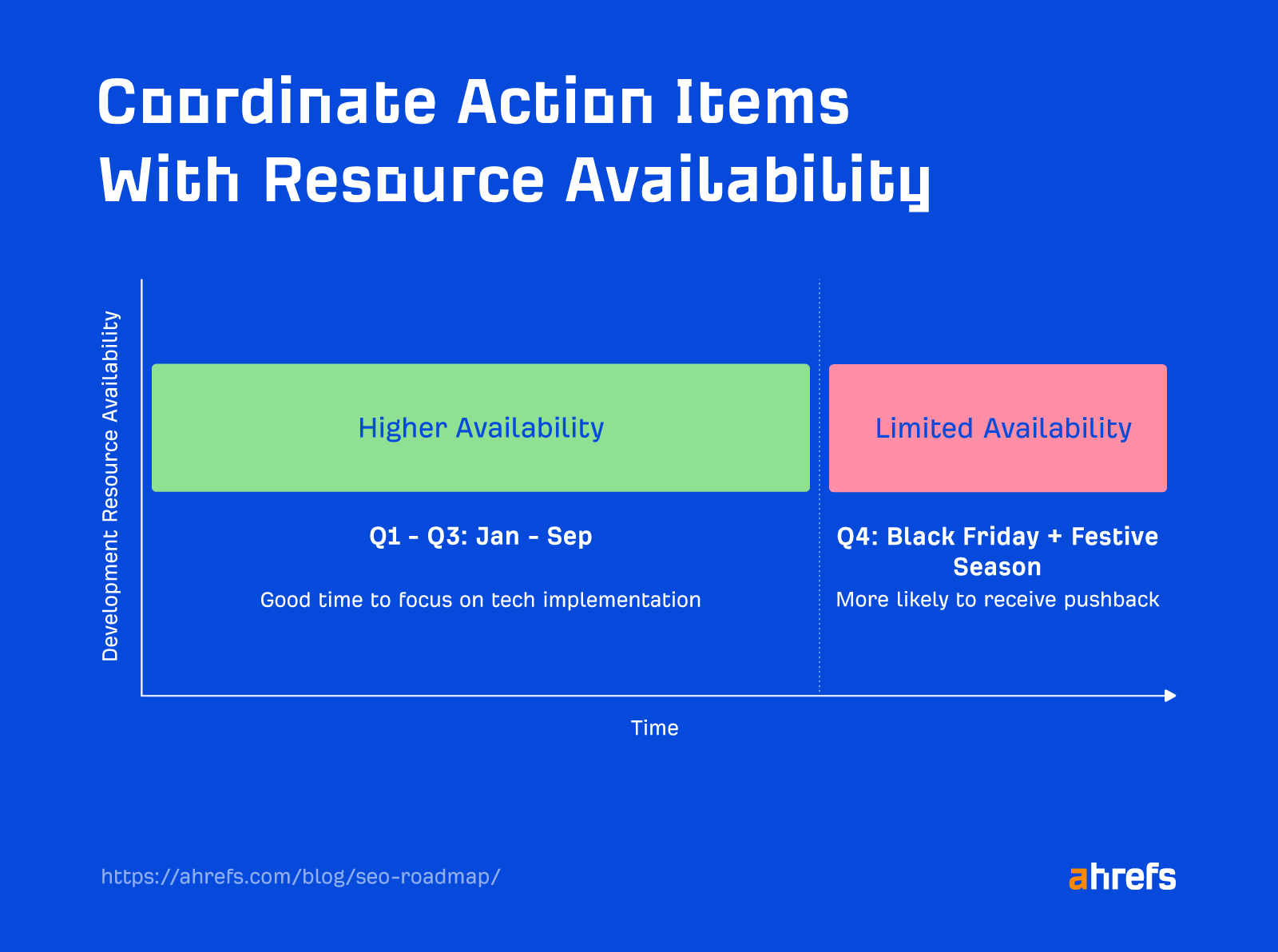
As a result, an action you could take is to move some all-important schema recommendations to an earlier stage in the roadmap to ensure they’ll be implemented in good time for Black Friday.
Another benefit to building an SEO roadmap is that it can help generate the buy-in for your long-term SEO strategy. Rome wasn’t built in a day, and it will naturally take some time to action and implement your SEO strategy. The SEO roadmap makes it easy to provide a visual view of what you’ll be working on over the next few months.

When you are ready to build your roadmap, you should have an understanding of:
In step #1, I’ll be sharing some examples of how you can quickly build up this knowledge within your first couple of months of the campaign.
I like to produce my roadmaps around the end of month two to the beginning of month three of an SEO campaign.
By the end of month one, you can start to have a strong idea of the key areas of focus for your campaign. That being said, I often find that it’s too early to build the full twelve-month SEO roadmap at this stage.
By the end of month two, I tend to have a broad and in-depth enough understanding of the strategy ahead to build the roadmap. It does however greatly depend on how you spend your time in those first couple of months.
Now you’re almost ready to start building your roadmap. Before it’s time to go through the steps, you may be wondering, “How much time should I set aside for actually building the roadmap?”
If you’re providing consultancy on a relatively small scale (e.g., fewer than three days per month), it could take around two to three hours to set up your roadmap.
On the other hand, if you are working on a larger consultancy basis or on a larger scope of work (e.g., 10+ days per month), this could take anywhere from half a day to a full day and beyond.
Step 1. Have your key SEO insights ready
To create your roadmap, you’ll want to lean on initial keyword research to have a good top-level understanding of content gaps and low-hanging fruit opportunities.
Starting your campaign with thorough keyword research is essential for making SEO projections and understanding where and how much time you should spend on your content. This can range from fresh content opportunities to existing content re-optimization.
A keyword gap analysis is an effective way to quickly gauge how much time you should spend on content.
To form your keyword gap analysis, use Ahrefs’ Content Gap tool to easily see what keywords your competitors rank for where you don’t rank.
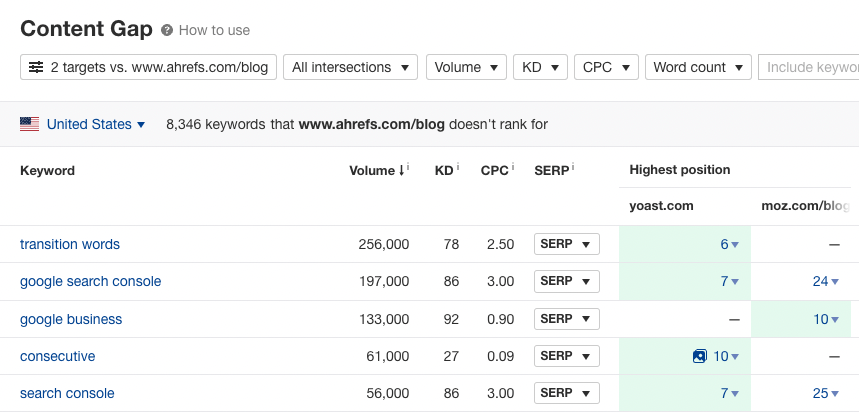
In similar fashion, you’ll want to do the same for technical tasks by leaning on key actions from a technical SEO audit. Ideally, you should already have a technical backlog from this audit. This makes it easy to slot your tasks into this list.
If you run regular site crawls via Ahrefs’ Site Audit, now is a great time to refresh yourself on key issues that will need addressing in your roadmap.
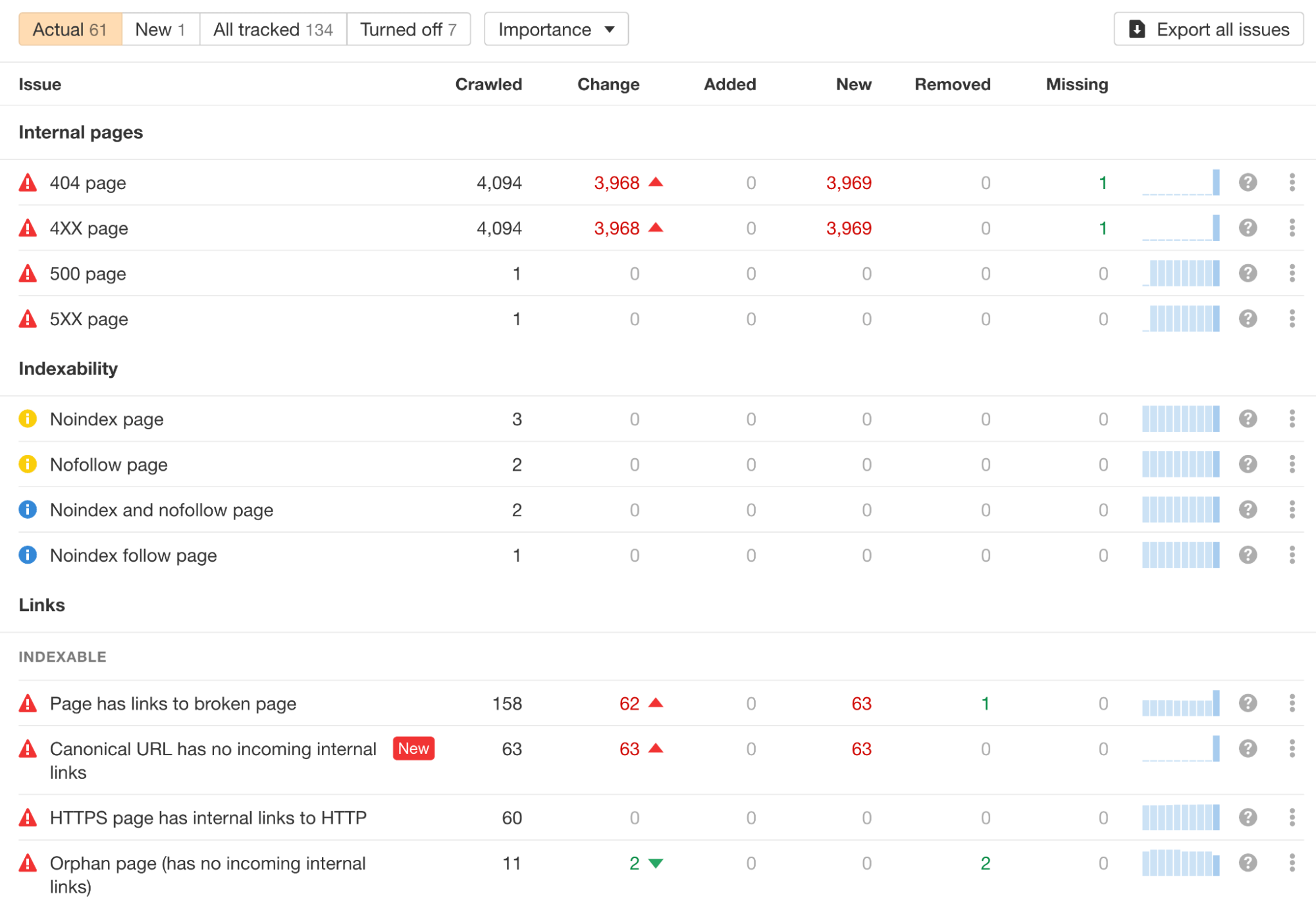
Depending on your approach to link building and team structure, you may wish to list out tasks relating to this too. That said, it’s perfectly fine to adopt a dedicated digital PR/link building roadmap if it suits your workflows better.
The Overview report in Ahrefs’ Site Explorer is a great starting point for understanding your backlink profile. Simply enter your domain and note down key metrics such as Domain Rating (DR), URL Rating (UR), total backlinks, and referring domains. This will prove to be a useful benchmark for the future.

You can also compare your backlink history (among other metrics such as traffic) vs. your competition via the “Performance” graph. Comparing by referring domains is a great way to quickly understand the rate at which backlinks have previously been acquired.
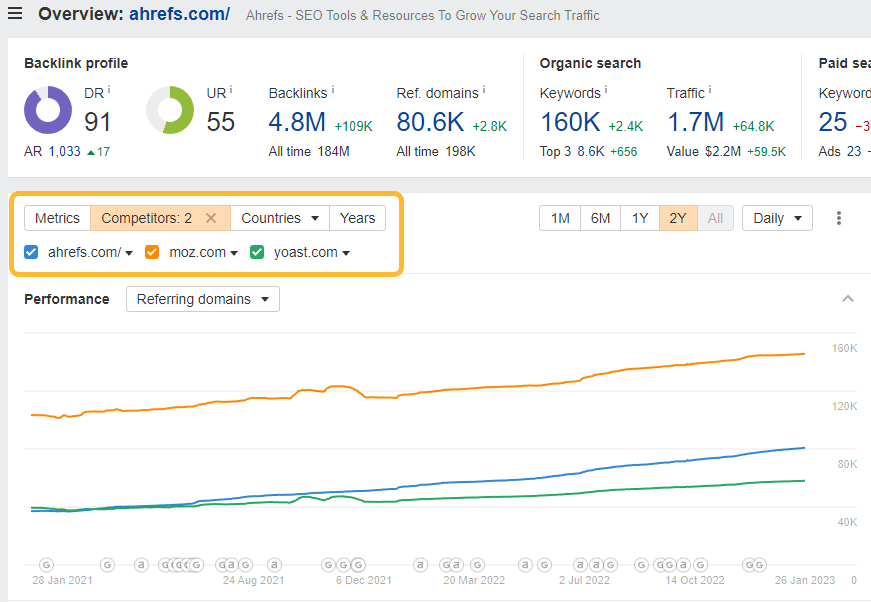
Step 2. List out your key tasks or workstreams
The best way to get the ball rolling is to simply write out a rough list of tasks and key workstreams that you feel could form part of your strategy over the next 12 months.
Note
If you haven’t heard of “workstreams” in this context, this may sound a bit confusing. This is simply the choice of wording we use at Kaizen to describe an overarching category of tasks.
You may prefer to call this “workflow” or another project management term. This is completely up to your personal preference.
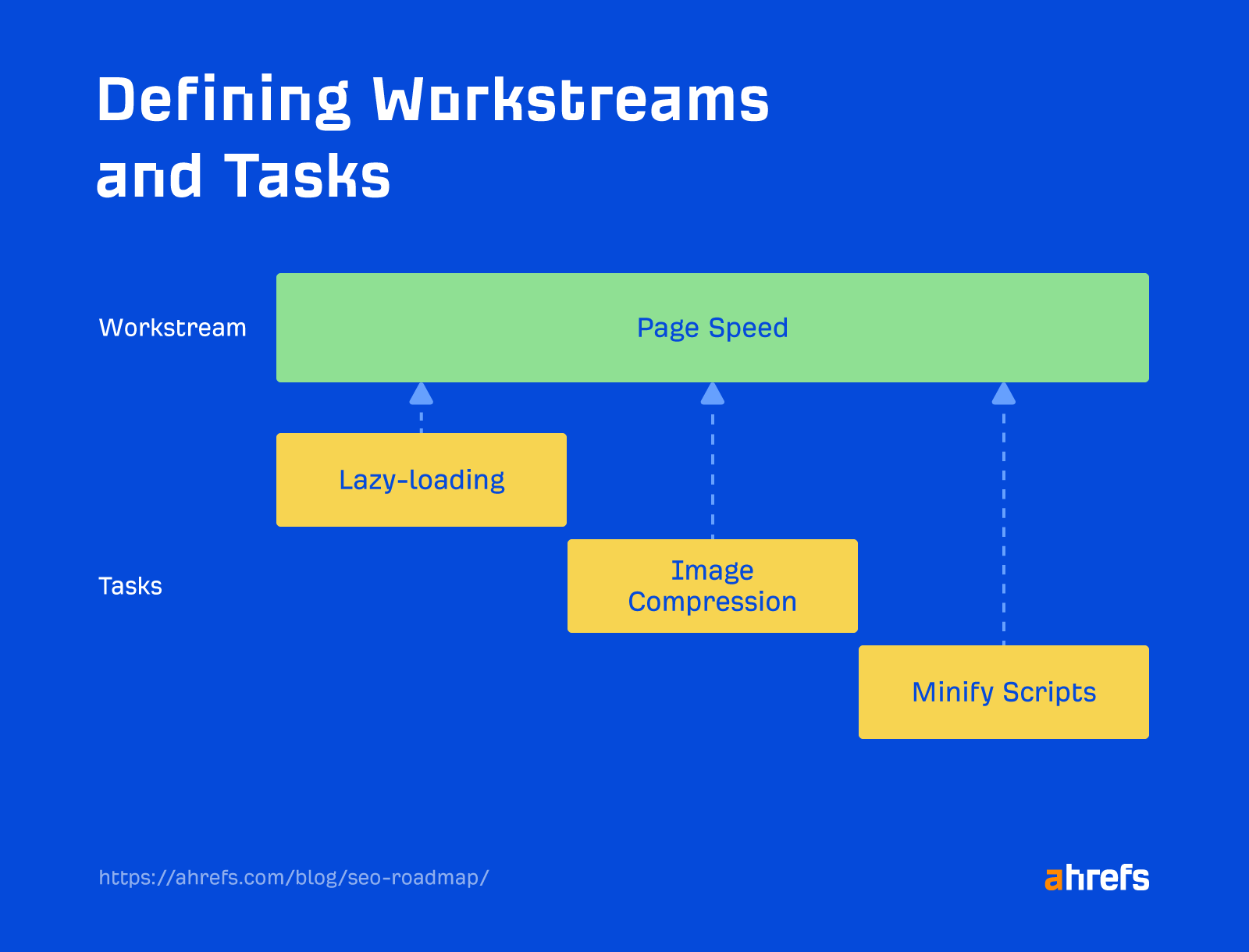
As you’re at an early stage of the campaign, you won’t have every detail covered, and that’s OK. Keeping with key workstreams and overarching tasks is a great starting point for your roadmap.
Say for example, you are working for an insurance provider that covers multiple verticals. Having “travel insurance article writing” is suitable at this stage as opposed to specifically listing out each article idea. It is a case of finding the right balance of detail, as going too broad (e.g., “article writing”) doesn’t provide a lot of direction.
If you’re fortunate enough to be working in a team, this is the perfect time to get everybody involved and to play their part in the creation of the roadmap. Get everyone together in person (or virtually) for an “ideation session” to brainstorm ideas for key tasks and workstreams as part of your strategy.
Here are some tips for an effective roadmap ideation session:
- Book in plenty of time (30-45 mins work well)
- Get everything down; even “bad ideas” help to get the ball rolling
- Keep all ideas visible to the team, as this can inspire further ideas
- Use post-it notes or retrospective tools like Metro Retro
- Have everyone involved anonymously vote for their favorites
By compiling the roadmap at around months two to three of the campaign, you won’t be aimlessly plucking random ideas for your strategy. After an effective first two months, you should start to have a good idea about what’s required as part of your strategy.
Not your first rodeo?
If you’re looking to create a roadmap for an existing strategy or to renew a completed roadmap, you’ll have the luxury of looking back on what worked well and what didn’t to form your list.
This is a great time to carry out a “Stop, Start, Continue” exercise. Be sure to pull together all relevant members of your team and extend the invite to key stakeholders and clients to ensure all possible feedback is taken into account.
The “Stop, Start, Continue” framework is simple:
Stop: What didn’t work and should not be included in future roadmaps?
Start: What didn’t we get around to but should be included?
Continue: What worked that we can do more of or nearly worked that we can improve?
Once again, post-it notes are great for this. If you are working remotely, be sure to utilize retrospective tools such as Metro Retro.

Step 3. Review and refine your task list
You may wonder, “How do I decide if a task should be included in my roadmap?” This aspect can certainly take a bit of getting used to. That said, the more strategies and roadmaps you build over time, the more you’ll develop a knack and instinct for what works for you.
As a general rule, I like to keep my roadmaps limited to tasks carried out by the SEO team only. Tasks for other teams such as developers and content writers should be kept in separate documents.
For example, developer actions fit nicely into a technical backlog while actions for copywriters can be kept within a dedicated content tracker document. This prevents the roadmap from becoming too detailed and too long.
If however there is a technical task that the SEO team needs to carry out before assigning actions into a technical backlog, then it makes perfect sense to include this as a task item in your SEO roadmap.
Bucketing tasks that are too granular into a single, larger task is another great technique to prevent your roadmap from becoming too big.
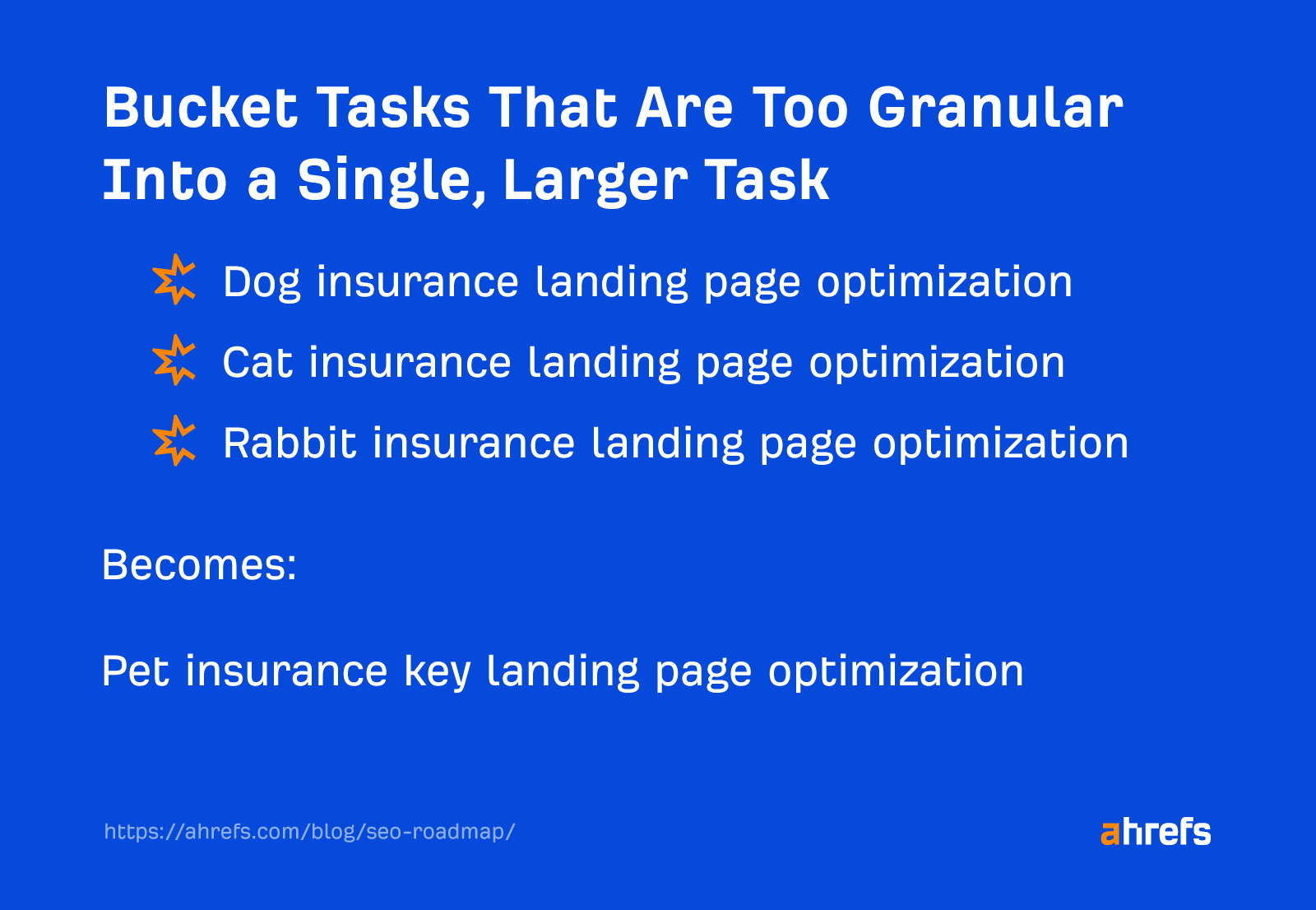
On the flip side, you should also avoid having tasks that are too broad, as this can lead to the roadmap not providing enough useful information. Similarly, you’ll want to avoid having tasks that are too big, as this can lead to a “flat” roadmap.
What you can do is to review your roadmap and break tasks that are too big or generic into smaller chunks.
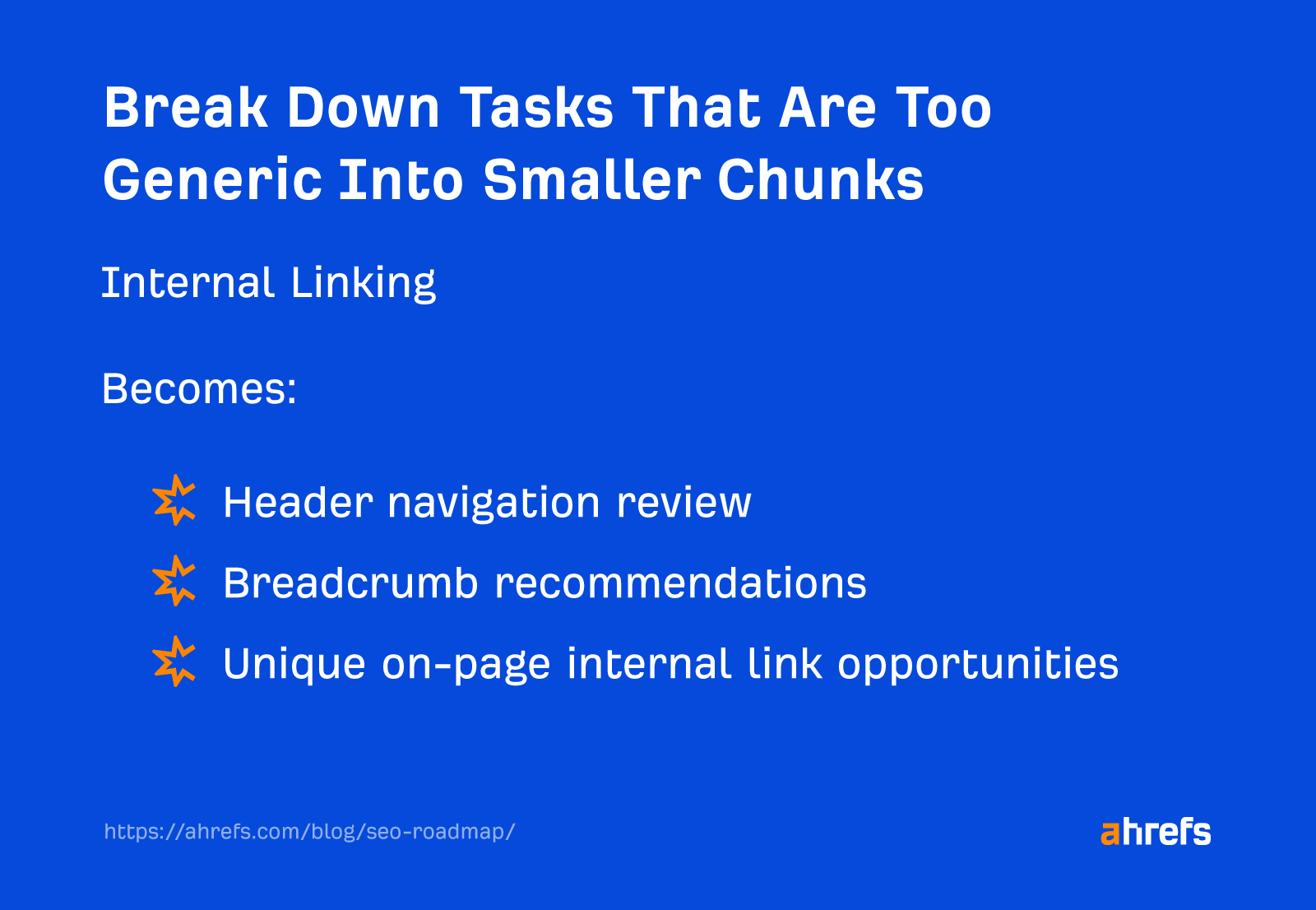
You are now in a great position to start loading your items into the roadmap. We’ve created an SEO roadmap template to save you from starting on a blank canvas. Feel free to make your own copy and edit the sheet to suit your needs.

Step 4. Prioritize your tasks logically
Once you have your roadmap task items in place, it’s time to prioritize them.
It’s highly likely after spending some time on this step that you won’t be 100% satisfied. That’s OK. It’s routine to continue to re-prioritize and make adjustments as you continue through the remaining steps and beyond. Remember to treat this as a “living” document.
That said, prioritizing effectively at this stage will reduce the amount of time you spend making adjustments in the future.
Following a prioritization framework, such as the Action Priority Matrix (also referred to as the “Impact Effort Matrix”), helps with effective prioritization. This ensures you’ll prioritize tasks that offer a strong impact relative to the required level of effort.
With the Action Priority Matrix, you’ll be putting tasks into four categories:
- Quick wins: high impact, low effort (highest priority)
- Long-term projects: high impact, high effort (high priority)
- Backlog: low impact, low effort (lower priority)
- Not going to happen: low impact, high effort (lowest priority)
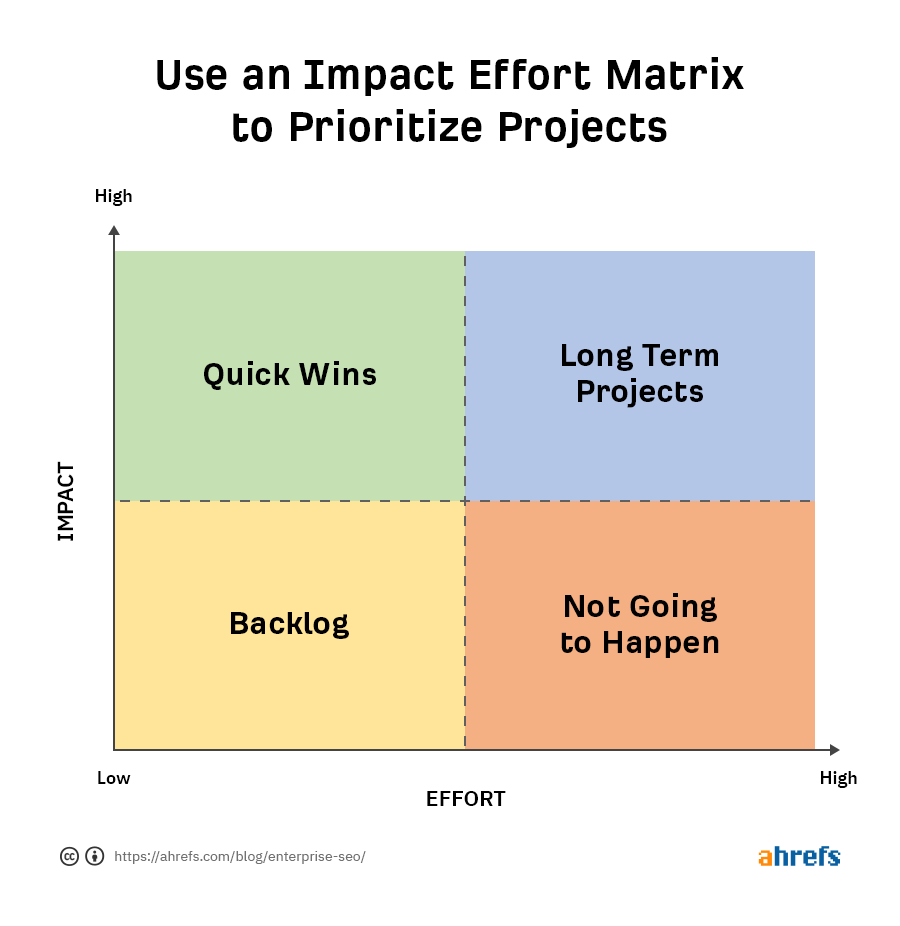
The best of quick wins should sit at the top of your roadmap. These are your impactful and easy-to-implement tasks. Getting these actioned early on means that it won’t take too long to start seeing some organic growth.
Be cautious about “front loading” every single one of your quick wins ahead of longer-term projects. Although you won’t see the results from long-term projects right away, if you hold off from simply getting started with these for too long, you could be holding yourself back in the long run.
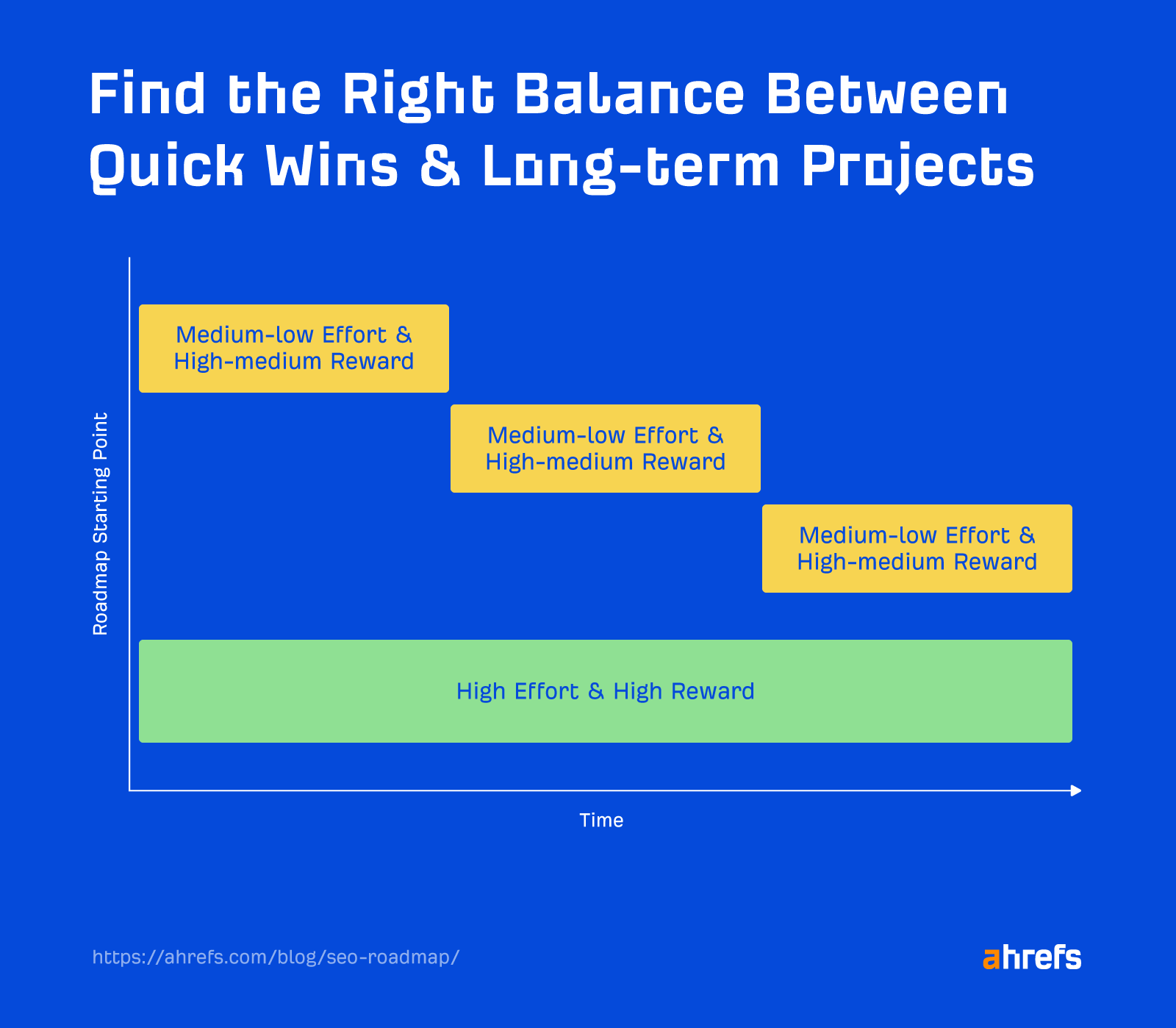
Task items within the backlog category will typically slot in nicely toward the end of the roadmap. While they don’t offer the highest of returns, they still play a part in your SEO strategy and are easy to implement.
In almost all cases, you’ll want to avoid including tasks with low impact that require high effort (“not going to happen” category). These take up much more time than they are worth and, in most cases, there are usually plenty of actions to be getting on with from the high-impact categories.
To re-prioritize roadmap items as you go, simply drag and drop the rows within the Google sheet.

The general aim here is to keep the items with the highest priority toward the top. It’s still no problem if you’re not 100% satisfied just yet. You’ll likely continue to re-prioritize as you naturally begin the next step.
Step 5. Assign time and resource to your items
By this stage, you’ll now be in a great position to start adding time estimates to your roadmap task items. This should be a relatively simple step, as you would have given this some thought as you began to prioritize your tasks.
This stage of the process may become a lot more difficult if you decide to include tasks that sit with non-SEO team members. This is because you’ll have to make a lot of assumptions on how long a task should take.
By only including tasks that are owned by the SEO department, you’re in a much stronger position to lean on your own experience and expertise to include time estimates for all items.
To include time estimates within the roadmap template, simply enter the number of days in the respective month column.
I personally go with the number of days as an estimate for the total time a senior member of staff would likely spend on the task. If a junior member of the team takes this task on, it’s worth taking into consideration that it may take longer to execute than the specified number of days.

This step can be somewhat “fiddly,” particularly if you are working as a consultant toward a set retainer. This shouldn’t be too time consuming though, especially once you get used to the process.
It’s usually a simple case of making slight refinements and adjustments to make sure the number of days balances out to match your designated capacity for SEO tasks.

I like to keep to half-day or full-day intervals. Anything more specific (such as hourly) can easily over-complicate the roadmap, so don’t be afraid to round your time estimates appropriately.
If you feel rounding a task up to half a day is too extreme, it’s possible that you’ve gone too granular with your task list. Now would be a great time to reconsider bucketing smaller tasks into bigger roadmap task items.
Don’t forget to account for regular BAU (business as usual) tasks. This can range from regular monitoring to reporting, such as monthly reports and quarterly business reviews (QBRs).
These regular tasks all take time, so don’t sell yourself short. Quite often, these tasks are forgotten about when it comes to creating the SEO roadmap.

You’re now in a great position to assign resource or task owners to roadmap items too.
This part of the roadmap is far from essential and can easily be removed if necessary. It is usually more useful when working in larger SEO departments or enterprise SEO teams.
Simply fill in the “Owner” column as and when you see fit.

Step 6. Assess and format in Gantt style for ease of use
At this stage, the SEO roadmap is nearly complete. Before shipping the document off to clients or sharing it around the company, it’s well worth spending a little time reviewing the roadmap to make any final adjustments or formatting changes.
Spend some time reading through the roadmap items to ensure everything aligns with your SEO strategy and vision.
I usually share my roadmaps with a senior SEO colleague to have everything sense-checked. If you have any internal QA processes or SOPs for reviewing key projects, now is the perfect time to apply these to your SEO roadmap.
I also spend some time making final adjustments to format my roadmap so the times and priorities flow in true Gantt chart style.
Ensuring the roadmap flows in a neat diagonal (from the top left to bottom-right corner) is not only aesthetically pleasing, it also makes the roadmap a lot easier to follow. It won’t always be perfectly straight and may deviate a little, but that’s expected.

You may have a key workstream that you plan to work on in different phases. To avoid disrupting the flow of the roadmap, don’t be afraid to break the workstream into two separate roadmap workstreams.
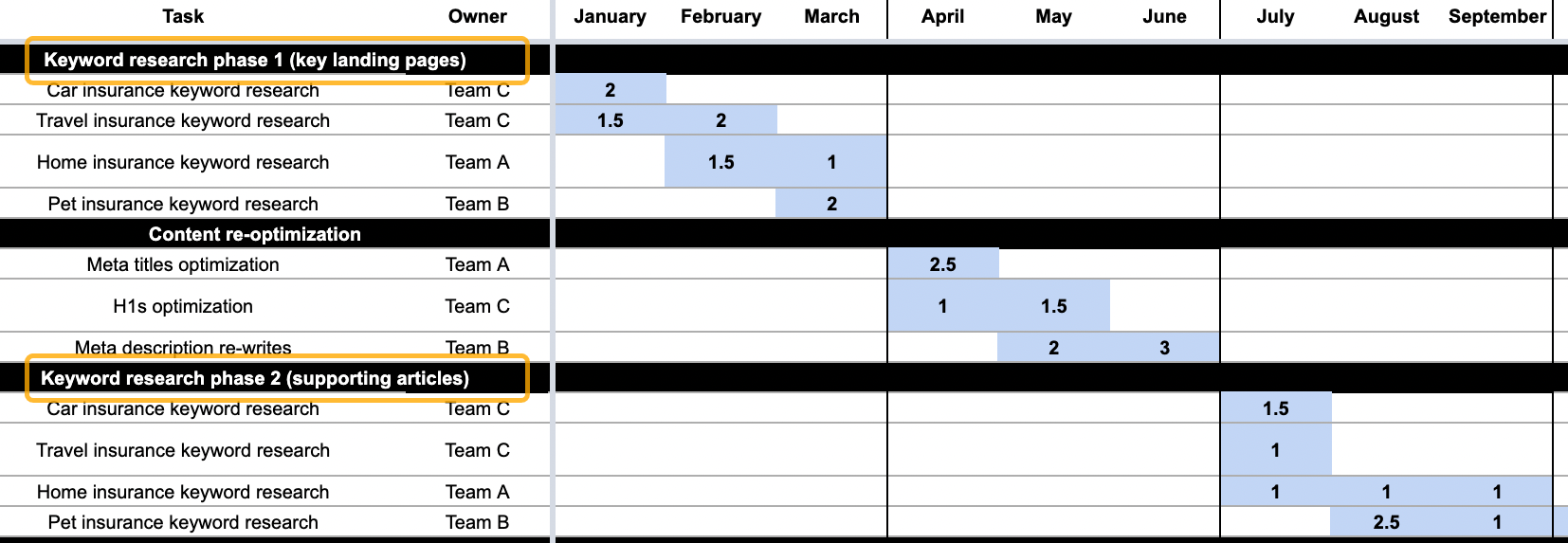
Now that you’ve made those final adjustments to the roadmap after receiving feedback from your team, you’re ready to start sharing your roadmap with your client (agency SEOs) or around the company (in-house SEOs).
Step 7. Regularly revise and update your roadmap
Although you’ve now “completed” and shared your roadmap around, it’s not the end of the road here.
As mentioned at the beginning of this article, the SEO roadmap is a “living” document. This means that edits or revisions could and should be made over time.
Be sure to update the status column as and when necessary so everybody is in the loop for when tasks are in progress and completed. Feel free also to add notes as you go to provide extra context. This column is the perfect place to link to any documents too.
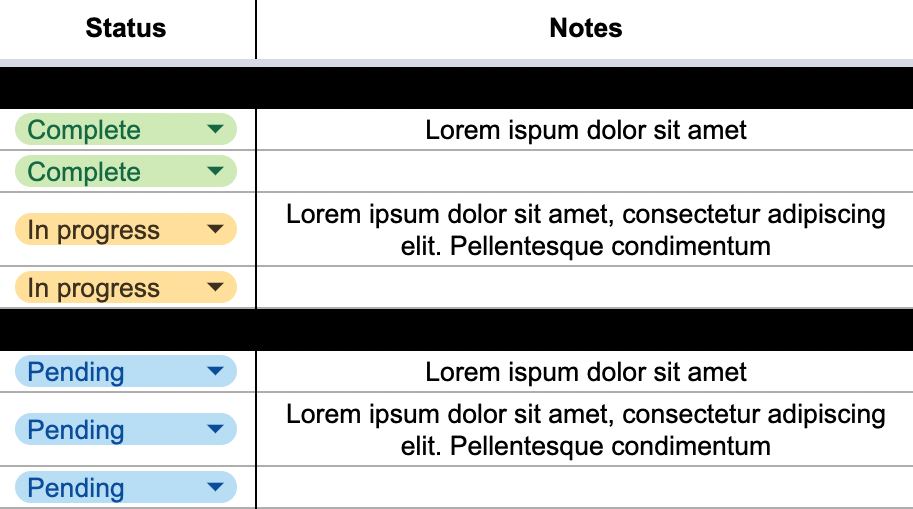
Don’t be afraid to make major changes or edits in the future too. SEO is an ever-evolving industry, and this is often reflected in planned strategies and subsequently your SEO roadmap.
You may also need to re-prioritize as you go based on learnings. Perhaps a certain task turns out to require more effort than anticipated. In this instance, you may wish to re-prioritize and favor a task that is more of a “quick win.”
When it comes to re-prioritizing your roadmap, simply adjust the number of days to suit.
Say for example, we need to move “Car insurance keyword research” from January to February and move “Travel insurance keyword research” to January. Simply remove the number of days entry from January and re-enter the number in the February column. I personally like to use cut-and-paste shortcuts to do this efficiently.
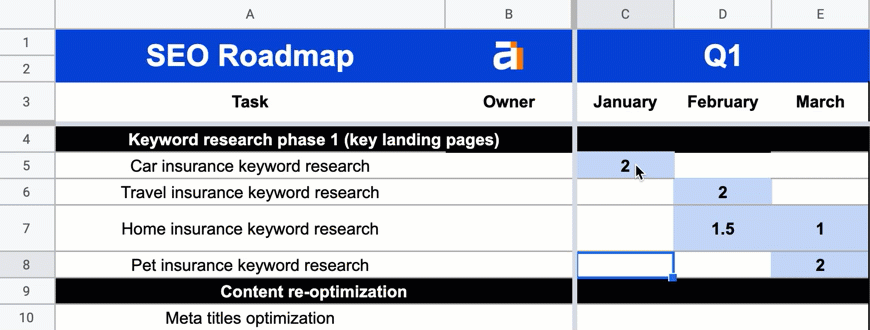
The same principle applies should you wish to add a whole new item into the roadmap. Simply add the new task as a new row and then adjust the day counts across the roadmap accordingly.
Perhaps you’ve been hit by the latest Google algorithm update and, as a result, you need to add a new task in and delay the existing tasks. (Fingers crossed you won’t need to do this.)
Final thoughts
Creating the SEO roadmap is one of my favorite tasks as an SEO consultant. I love to strategize and feel this is where I really thrive. Hopefully, this step-by-step approach, along with the template, makes setting the SEO roadmap an enjoyable process for you too.
What’s great is you don’t necessarily need to have several years of experience to give building your first SEO roadmap a shot. Starting out a roadmap is a great way for junior staff to put their knowledge to the test and have substantial input on a key document.
Key takeaways:
- Plan to build your roadmap at around month two to three of an SEO campaign
- Ensure you have a well-rounded, top-level understanding of the state of play first
- Use this as an opportunity to pull the full team together to collaborate on strategy
- Prioritize effectively by using the Impact Effort Matrix
- Treat the roadmap as a “living” document by keeping it up to date and making adjustments where necessary
Have any questions? Ping me on Twitter and let me know.













You must be logged in to post a comment Login